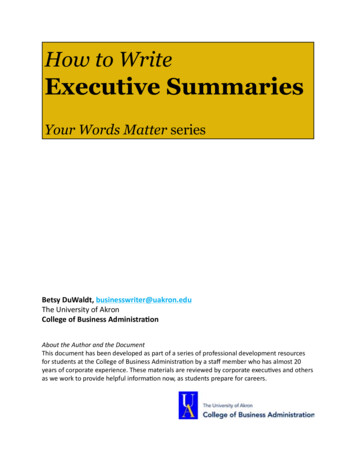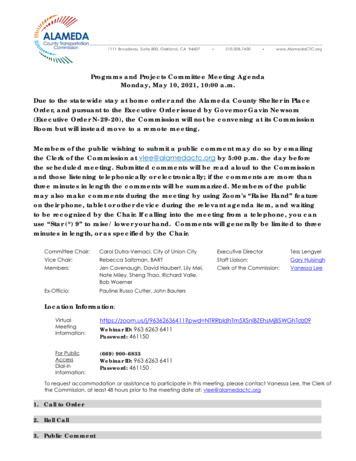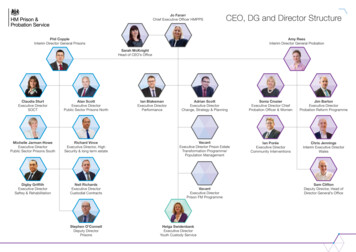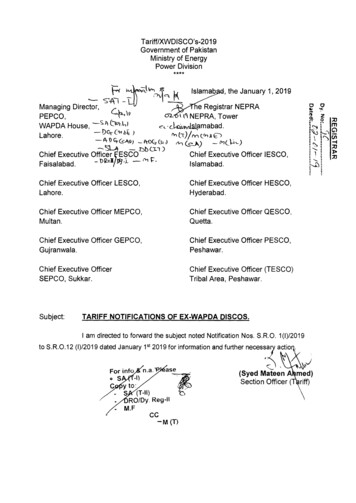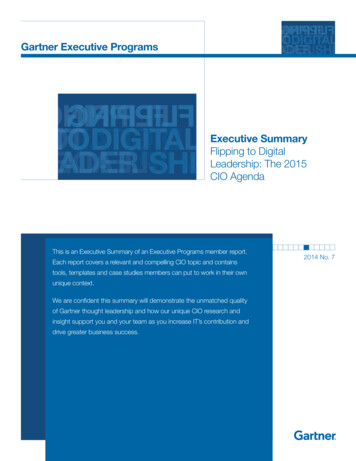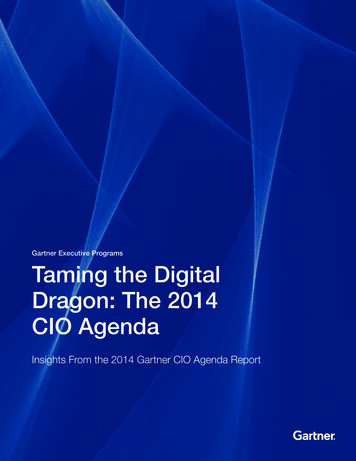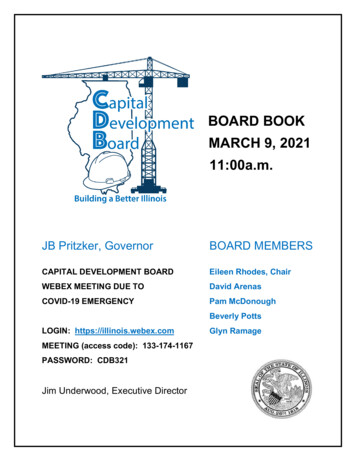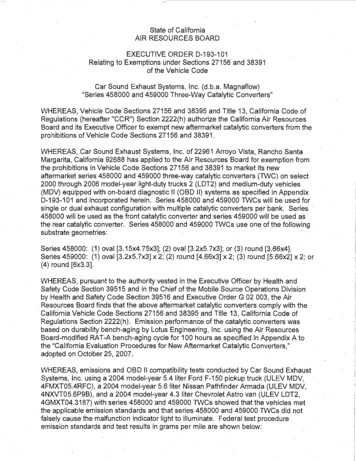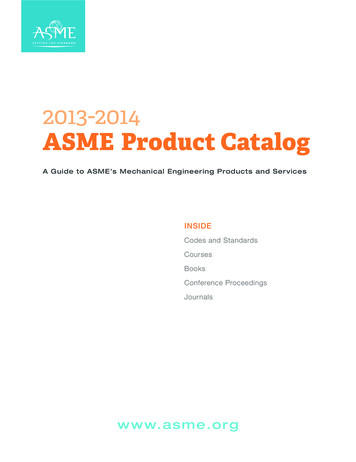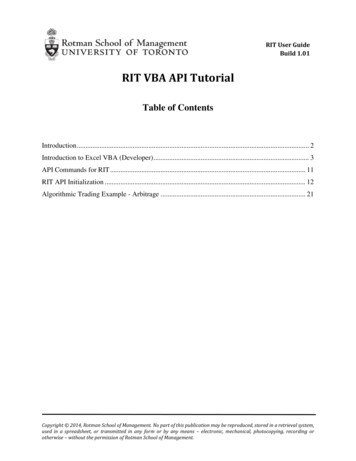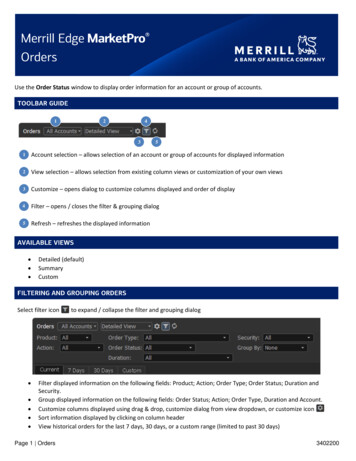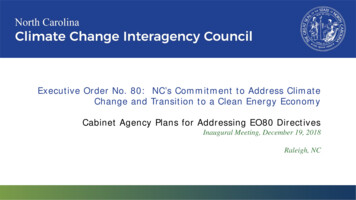
Transcription
Executive Order No. 80: NC’s Commitment to Address ClimateChange and Transition to a Clean Energy EconomyCabinet Agency Plans for Addressing EO80 DirectivesInaugural Meeting, December 19, 2018Raleigh, NC
Agenda1. Welcome and Introductions Welcome (DEQ Secretary Michael Regan)Opening Remarks (Governor Roy Cooper)Council Introductions (Cabinet Agency Secretaries and their Designees)2. Executive Order No. 80 and Council Process 10:10-10:55DEQ – Clean Energy Plan, Climate Risk Assessment and Resiliency Plan,State Buildings Energy Savings ProgramDOT – NC Zero Emission Vehicle (ZEV) PlanDOC – Clean Energy and Clean Transportation Workforce AssessmentsDOA – NC Motor Fleet ZEV PlanBREAK10:55-11:054. Cabinet Agency Plans for Addressing General Directives (25 mins)11:05-11:30 Each agency discusses how climate change is impacting its programs and operations.5. Public Engagement29:55-10:10Overview of EO80 (Jeremy Tarr, Governor’s Office)Overview of Council’s Operating Procedures and Meeting Schedule (Sushma Masemore, DEQ)3. Cabinet Agency Plans and Stakeholder Process for Addressing Specific Directives 9:30-9:5511:30-12:00
Executive Order No. 80:North Carolina’s Commitment to Address Climate Change andTransition to a Clean Energy Economy3
State GoalsThe State of North Carolina will strive to accomplish thefollowing by 2025:a. Reduce statewide greenhouse gas emissions to 40% below2005 levelsb. Increase the number of registered, zero-emission vehicles(ZEVs) to at least 80,000c. Reduce energy consumption per square foot in state-ownedbuildings by at least 40% from fiscal year 2002-2003 levels4
N.C. Climate Change Interagency CouncilComposition. The secretary or designee of each cabinet agency and arepresentative of the Governor’s OfficeCouncil Chair. Secretary Regan, N.C. Department of Environmental QualityCouncil Duties Recommend new and updated goals and actions to meaningfully address climatechangeDevelop and implement programs and activities that support climate mitigation andadaptationConsider stakeholder input when developing recommendations, programs, andactivitiesSchedule, monitor, and provide input on the preparation and development of theplans and assessments required by EO 80Review and submit to the Governor EO 80 plans and assessmentsStatus Update on Implementation. To Governor by Oct. 15, 2019.5
Specific DirectivesDepartment of Environmental QualityN.C. Clean Energy Plan to encourage the increased utilization of clean energytechnologies in the public and private sectors. Due Oct. 1, 2019.Updated Comprehensive Energy, Water, and Utility Use Conservation Program,which includes best practices and guidance to help achieve the state building efficiencygoal in EO 80. Due Feb. 1, 2019 and Dec. 1, 2019.N.C. Climate Risk Assessment and Resiliency Plan to provide a scientificassessment of current and projected climate impacts on North Carolina and prioritizeeffective resiliency strategies. Due Mar. 1, 2020.Greenhouse Gas Inventory that estimates North Carolina’s statewide net GHGfootprint.Department of TransportationN.C. Zero-Emission Vehicle Plan designed to achieve the ZEV target and addresstopics such as ZEV corridors and ZEV infrastructure. Due Oct. 1, 2019.6
Specific DirectivesDepartment of CommerceClean energy and clean transportation workforce assessments thatevaluate current and future workforce needs, assess the skills and educationrequired for employment, and recommend actions to help North Caroliniansdevelop such skills and education. Due Oct 1, 2019.Department of AdministrationN.C. Motor Fleet Zero-Emission Vehicle Plan that identifies feasible tripsfor a ZEV, recommends needed infrastructure, addresses ZEV procurementoptions, and includes other key strategies for increasing ZEV use. Due Oct. 1,2019.Accounting of each agency’s number of ZEVs and miles driven by vehicle type.Due Oct. 1, 2019.7
General Directives to All Cabinet AgenciesAssess and Address Climate Change Evaluate the impacts of climate change on agency programs andoperations Integrate climate change mitigation and adaptation practices intoagency programs and operations Support communities and sectors vulnerable to climate changeimpactsSupport Clean Energy Business. Take actions that support theexpansion of clean energy businesses and service providers, cleantechnology investment, and companies committed to procuringrenewable energy.8
General Directives to All Cabinet AgenciesProcure and Use Zero-Emission Vehicles. Prioritize ZEVs in thepurchase or lease of new vehicles and use ZEVs for agency businesstravel when feasible. When ZEV use is not feasible, prioritize costeffective, low emission alternatives.Improve Energy Consumption. Develop and implementstrategies to support the state building efficiency goal in EO 80. Designate an energy point of contact. Due Jan 15, 2019. Develop a utility management plan. Due Mar. 1, 2019. Report annually on utility consumption. Due Sept. 1, 2019.9
Contact InformationJeremy TarrPolicy AdvisorN.C. Governor’s OfficeJeremy.Tarr@NC.gov10
Overview of Climate Council’s Operating Procedures andMeeting Plans11
Cabinet Secretaries Designees Two Designees from Each Cabinet Agency - Executive and Program Level Primary points of contact for their agency. Participate in regular interagency meetings to discuss strategic direction, plan council meeting agendas,prioritize activities, address public input, and take actions to achieve the goals of EO80. Participate in Council meetings as assigned to fulfill duties specified in EO80, Section 3 a-f. Attain authority to ensure EO80 directives are being carried out throughout the agency. Support planning, communication, and interactions with stakeholders. Communication with the Public DEQ will maintain a web portal https://deq.nc.gov/energy-climate/climate-change Cabinet agencies will maintain own web pages, linked to DEQ portal Implementation status updated Stakeholder meeting information provided Agendas posted Interested groups may sign up for regular updates via email Social media presence12
Climate Council Meeting Plans1st Meeting:December 19, 2018, attended by cabinet secretaries, Raleigh2nd Meeting:February 2019, attended by Secretary’s designees, Raleigh Agency Status Reports and Public Engagement PeriodDates and details posted at:3rd Meeting: April 2019, attended by Secretary’s designees, Eastern N.C. https://deq.nc.gov/climate-council Agency Status Reports and Public Engagement Period4th Meeting:June 2019, attended by Secretary’s designees, Western N.C. Agency Status Reports and Public Engagement Period5th Meeting: August 2019, attended by Secretary’s designees, Raleigh Agency Status Reports and Public Engagement Period136th Meeting:September 2019, attended by cabinet secretaries, Raleigh Review and Approval of Agency Reports Due October 1, 2019 Public Engagement Period7th Meeting:November 2019, attended by Secretary’s designees, Eastern N.C. Agency Status Reports and Public Engagement Period
Cabinet Agency Specific Directives14
Clean Energy Plan Development ProcessEO80 Section 41.General Description of Approach Stakeholder engagement to receive feedback on a vision for NC’s energy future Identify stakeholder needs, issues, barriers, solutions, opportunities unrealized, equity concerns, and actionsrequired Analyze future energy demand, generation and supply strategies, national trends in power gridmodernization/transformation, and explore future options for NC Assess economic opportunity, rate impacts, environmental benefits, health impacts, and jobs outlook for thevisionary energy future Recommend policy, regulatory, administrative, local government, public, and business community actionsto meet the vision2.Public Engagement Process Open process throughout plan development (surveys, meetings, teleconferences, forums, etc.) Initial stakeholder schedule to be released in January 2019 Initial public meeting (Raleigh) General listening sessions (throughout the state) Facilitated stakeholder process for focused topic areas (throughout the state)15
Clean Energy Plan Development Process3. Anticipated Timeline Jan. 2019 – March 2019: Public engagement, vision development, issues and solutions development April 2019 – May 2019: Technical analysis and quantification of economic, environmental, cost, andgrid reliability impacts May 2019 – June 2019: Draft Plan development July 2019 – Aug. 2019: Public comment period Sep. 2019: Revised plan provided to the Climate Council Oct. 2019: Final plan submitted to the Governor4. Communication Methods Email distributions, press releases, social media, other announcements Stakeholder meeting information sessions (general and focused, structured deep dives) Regular postings on website: https://deq.nc.gov/climate-council16
Clean Energy Plan Stakeholders Distributed energy resource/renewable energy system providers and integrators Investor owned utilities, municipalities, and electric cooperatives Local governments, council of governments and other supporting entities Elected officials Large corporate, business and finance groups Manufacturing and industrial organizations and trade associations Healthcare and commercial buildings sector Higher education institutions Environmental justice, under-served communities and faith-based organizations Affordable housing and community development organizations Consumer advocates Youth and students Environmental organizations Energy efficiency system and service providers Others (to be defined per suggestions)17
Climate Risk Assessment and Resiliency PlanDevelopment ProcessEO80 Section 91.General Description of Approach Stakeholder engagement to draw upon existing body of work and identify new areas for inclusion into a Resiliency Plan Collective effort from all cabinet agencies required Explore hazards Convene science and climatological experts to develop a North Carolina specific climate assessment Assess climate stressors based on past weather events and future climate trends/variability; Assess non-climate stressors Explore threats, hazards and impacts to public and private value streams Prioritize areas and issues to address climate adaptation and resiliency grouped by sector and region Assess vulnerability and risks incorporating technical and local knowledge Develop a Resiliency Plan Explore integration with hazard mitigation and comprehensive land use planning Investigate options and solutions for highest risks Evaluate costs, benefits, losses, and feasibility Prioritize options and develop Resiliency Plan with evaluation metrics Update Resiliency Plan every 3-5 years (as recommended by stakeholders)18
Climate Risk Assessment and Resiliency PlanDevelopment Process2. Public Engagement Process Open process throughout plan development (meetings, teleconferences, forums, etc.) Facilitated stakeholder process for select groups/categories (throughout the state, emphasis on local government) Cabinet agency led efforts to address risks and vulnerabilities associated with their programs DEQ Natural & Working Lands Stakeholder Group met in October and December3. Anticipated Timeline Jan. 2019 – May 2019: State climate assessment and hazards assessment performed by subject matter experts June 2019 – Aug 2019: Vulnerability and risk assessment conducted through stakeholder meetings Aug. 2019 – Oct. 2019: Explore options/solutions and prioritize feasible actions Dec. 2019: Draft North Carolina Climate Risk Assessment and Resiliency Plan to public comment Feb. 2020: Revised plan provided to the Climate Council March 2020: Final plan submitted to the Governor4. Communication Method Email distribution, press releases, social media, partnership networks and other announcements Regular postings on websites:https://deq.nc.gov/climate-council and esiliency19
1.State Buildings Utility Savings Initiative (USI)Implementation ProcessEO80 Section 8General Description of Approach Revise the Comprehensive Program to further reduce cabinet agency building energy usage Promote best practices for state government buildings energy efficiency and provide training to energy managers andstaff Adopt a standard methodology for calculating energy consumption per gross square foot and emissions tracking towardreduction goals in Section 1 Encourage and assist Council of State members, higher education, K-12, and local government to further reduce energyconsumption Maintain agency reporting requirements pursuant to G.S. 143-64.12 (a), Biennial Agency Utility Management Plan and annual Agency Utility Reports Annual Utility Report that describes the Comprehensive Program and summarizes achieved reductions in energyconsumption2.Public Engagement Process Meetings, teleconferences, etc. to assist with plan and program development Assist agencies and other public building owners in understanding their utility data20
USI Plan Development Process3. Anticipated Timeline January 15, 2019, collect cabinet agency energy manager information February 1, 2019, update and amend Comprehensive Energy, Water, and Utility UseConservation Program March 1, 2019, collect cabinet agency utility management plans and assess the adequacy ofthe plans with EO80 September 1, 2019, agency Annual Utility Reports due December 1, 2019, Annual report on Comprehensive Energy Program and agency utilityconsumption, costs and achievements4. Communication Method Site visits, telecommunication, emails, meetings Posting on website: resources/utilitysavings-initiative21
USI Plan Stakeholders 22Cabinet agenciesHigher Education InstitutionsCommunity CollegesK-12 SchoolsLocal GovernmentsTreasurer OfficeOSBM
Zero Emission Vehicle (ZEV) Plan Development ProcessEO80 Section 51.General Description of Approach Create a multidisciplinary team to create a specific plan to follow through on EO80 Approximately 9,000 Electric Vehicles already registered in NC Continue working with DEQ on Phase 1 plans for the ZEV infrastructure allocation of funds from the VW Air QualityViolation Settlement Further advance work on Alternative Fuel Corridors – several segments of the state’s interstates are already identifiedas Alternative Fuel Corridors. Some are “signage ready” for compressed natural gas (CNG) and/or EV fast charging “Start at home” by identifying when and where electric vehicles can be included in NCDOT’s fleet (EO80 Section 7) Leverage our long-range planning efforts (NC Moves 2050) to identify short term, near term, & long term initiatives2.Public Engagement Process Create a NCDOT specific Climate Change Commitments webpage Utilize NCDOT’s current public involvement processes Virtual Public Involvement (VPI) Continued participation in EV workgroups which include public as well as government &commercial stakeholders23
ZEV Plan Development Process3. Anticipated Timeline Jan 2019: Develop multidisciplinary team and establish webpage needs February – Mar 2019: Public engagement, plan development, potential issue/solutions identification Apr 2019 – May 2019: Technical analysis and quantification of economic costs & environmental benefits May 2019 – Jun 2019: Draft Plan development Jul 2019 – Aug 2019: Public comment period Sep 2019: Revised plan provided to the Climate Council Oct 2019: Final plan submitted to the Governor4. Communication Method Website existing NCDOT public involvement including VPI DMV offices Ready NC app24
Clean Energy and Clean TransportationWorkforce Assessment ProcessEO80 Section 6251.General Description of Approach (For each sector – Clean Energy & Clean Transportation) Identification of existing talent pool and future workforce demand Assessment of employers’ current and future workforce skills and training needs Compilation of educational program offerings, enrollment trends, and work-based learning opportunities Identification of gaps and areas for improvement to meet current and future workforce demand Recommended actions to help North Carolinians develop the required skills and education2.Public Engagement Process Consult with organizations in energy and transportation sectors to identify industries and employers Consult with identified employers regarding current and future skill needs as well as challenges Consult with public and private education institutions regarding program offerings, enrollment trends, andwork-based learning opportunities Solicit public comments on draft recommendations before finalizing
Workforce Assessment Process3. Anticipated Timeline Jan 2019 – Feb 2019: Consultation with industries, employers, and education institutions March 2019 – May 2019: Data gathering, technical analysis, and quantification of findings May 2019 – Jun 2019: Draft assessment development Jul 2019 – Aug 2019: Public comment period Sep 2019: Revised assessment provided to the Climate Council Oct 2019: Final assessment submitted to the Governor4. Communication Method Email distribution, press releases, other announcements Regular postings on website: http://www.nccommerce.com26
Workforce Assessment Stakeholders Public, private, and nonprofit organizations engaged in the production, transmission, provision, ordistribution of clean energy or clean transportation products or services Public, private, and nonprofit organizations engaged in the evaluation or promotion of clean energy orclean transportation products or services Public or private education institutions engaged in offering educational programs, apprenticeships, orwork-based learning opportunities associated with jobs in the clean energy or clean transportation sectors Students or workers with interest or experience in employment in the energy or clean transportationsectors Others (to be defined per suggestions)27
Motor Fleet ZEV Plan Development ProcessEO80 Section 7281.General Description of Approach Stakeholder engagement to seek input on ZEV priorities Determination of stakeholder issues, barriers, opportunities and support required for ZEV priorities Identify types of feasible ZEV trips; develop procurement options and strategies to increase ZEV purchasesand utilization; account for each agency’s ZEV utilization Recommend policy and actions needed to support ZEV priorities2.Public Engagement Process Meetings, teleconferences and surveys
Motor Fleet ZEV Plan Development Process3. Anticipated Timeline January 2019 – May 2019: May 2019 – June 2019: July 2019 – August 2019: September 2019:Stakeholder engagement and information gatheringData analysis and quantification of economic costDraft Plan development and review with stakeholdersSubmit Plan to Council to submit to the Governor4. Communication Method Email Agency websites Agency social media accounts Newsletters29
Motor Fleet ZEV Plan Stakeholders Cabinet agencies Council of State agencies Local governments, and community colleges UNC System member institutions Community Colleges North Carolina citizens30
Cabinet Agency General Directives Reports by Cabinet Agencies31
Cabinet Agency Points of Contact32
Department of Environmental QualitySecretary Michael ReganExecutive DesigneeSushma Masemore, PEDeputy Assistant Secretary for EnvironmentEnergy ram DesigneeTancred MillerCoastal & Ocean Policy ManagerDivision of Coastal oby Vinson, PESection ChiefDivision of Energy, Mineral and Land Resources919-707-9201Toby.vinson@ncdenr.gov
Department of TransportationSecretary Jim TrogdonExecutive DesigneeBobby LewisNCDOTChief Operating Officer919-707-2820rwlewis1@ncdot.govChristopher Werner, PEDivision of HighwaysTechnical Services Administrator919-707-2540cmwerner@ncdot.govProgram DesigneesColin Mellor, LGEnvironmental Policy Unit919-707-6139cmellor@ncdot.gov34Heather HildebrandtStatewide Initiatives Group919-707-0964hjhildebrandt@ncdot.govEric FrazierFacilities Management Unit919-707-4554erfrazier@ncdot.gov
Department of CommerceSecretary Anthony CopelandExecutive DesigneeGeorge Sherrill, MPAChief of StaffOffice of the am DesigneeJohn Hardin, PhDExecutive DirectorOffice of Science, Technology & Innovation919-814-4639jhardin@nccommerce.com35
Department of AdministrationSecretary Machelle SandersExecutive DesigneeMark EdwardsDeputy Secretarymark.edwards@doa.nc.gov36
Department of Public SafetySecretary Erik HooksExecutive DesigneeDoug HolbrookDeputy Secretary/Chief Financial OfficerOffice of the Secretarydoug.holbrook@ncdps.govProgram DesigneePaul BraeseEnergy Program EngineerPaul.Braese@ncdps.gov37
Department of Health and Human ServicesSecretary Mandy CohenExecutive DesigneeIris B. CooperAssistant SecretaryProcurement, Contracts & GrantsIris.Cooper@dhhs.nc.govProgram DesigneePeter J. VeitChief, Facilities Engineering & ConstructionPeter.Veit@dhhs.nc.gov38
Department of Natural and Cultural ResourcesSecretary Susi HamiltonExecutive DesigneeReid WilsonChief Deputy Secretaryreid.wilson@ncdcr.govProgram DesigneeErin LawrenceDirector of Capital Projectserin.lawrence@ncdcr.gov39
Department of Military and Veterans AffairsSecretary Larry HallExecutive DesigneeAriel AponteInter-Agency CoordinatorAriel.Aponte@milvets.nc.govProgram DesigneeAngella DunstonDirector of CommunicationsAngella.Dunston@milvets.nc.gov40
Department of RevenueCabinet Secretary DesigneesExecutive DesigneeAngela AlticeAssistant Secretary of Business Services and Support919-754-2330Angela.Altice@ncdor.govProgram DesigneeMatt KingBusiness Operations Facilities Manager919-814-1164Matthew.King@ncdor.gov41
Department of Information TechnologyCabinet Secretary DesigneesExecutive DesigneeNate DennyChief of staff919-754-6715nate.denny@nc.govProgram DesigneeHenry KaylorDirector, Eastern Data Center Services919-754-6320henry.kaylor@nc.gov42
Thank you.43
Assess and Address Climate Change Evaluate the impacts of climate change on agency programs and operations Integrate climate change mitigation and adaptation practices into agency programs and operations Support communities and sectors vulnerable to climate change impacts Support Clean Energy Business. Take actions that support the
